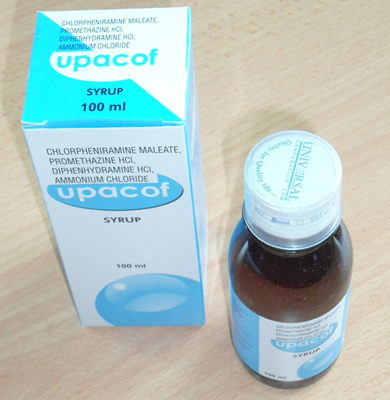
Upacof Syrup
Composition
Each 5 ml of syrup contains:
- Chlorpheniramine Maleate B.P ………………………… 1 mg/5ml
- Promethazine HCl B.P……………………………………2.5 mg/5ml
- Diphenhydramine HCl B.P…………………………….. 5 mg/5ml
- Ammonium Chloride B.P………………………………. 90 mg/5ml
Pharmacological actions:
- Chlorpheniramine Maleate, Promethazine and Diphenhydramine are all antihistamines with H1 receptor antagonistic action.
- They inhibit most responses of smooth muscle to histamine. Histamine is usually released from the mast cells on encounter with antigens.
- The antihistamine antagonizes the constrictor action of histamines on the respiratory smooth muscle. H1 antagonists also possess antimuscarinic, adrenaline- enhancing and/ or antagonizing, serotoin antagonizing and local anesthetics effects. Chlorpheniramine also binds to H1 receptors in the Central Nervous System.
- H1 antagonists are used for the palliative treatment of allergic reactions.
- Ammonium Chloride is used as an expectorant due to its irritant action on the gastric mucosa.
Pharmacokinetics:
- The antihistamines are generally readily absorbed from the gastrointestinal tract. They undergo considerable first pass metabolism in the liver. They are bound to plasma proteins and are also well distributed in the Central Nervous System. They induce the hepatic microsomal enzymes and thus facilitate their own elimination. Chlorpheniramine Maleate is metabolized to desmethyl and didesmethyl Chlorpheniramine. Promethazine is metabolized to Promethazine Sulphoxide and N-desmethyl Promethazine.
- The unchanged drugs and their metabolites are excreted primarily in urine and the excretion is dependent on urinary pH and flow rate.
- Promethazine is excreted slowly via urine and bile.
- Ammonium chloride is effectively absorbed from gastrointestinal tract.
- The Ammonium ion is converted into urea in the liver.
- Sodium citrate, after absorption, is metabolized to bicarbonate.
- Ephedrine is readily and completely absorbed from the gastrointestinal tract. It is largely excreted unchanged in urine, together with small amounts of metabolites produced by hepatic metabolism.
Indications:
Symptomatic treatment of cough and colds where a decongestant and expectorant effect is of beneficial value.
Dose:
- Children: 1 – 6 years: 2.5 ml (½ teaspoonful) 3 to 4 times a day.
- 6 – 12 years: 5 ml (1 teaspoonful) 3 to 4 times a day.
- Adults and children over 12 years: 10 ml (2 teaspoonfuls) 3 to 4 times a day.
Side effects:
- The side effects encountered are rarely serious and disappear with continued therapy. They can however, sometimes be very troublesome, thus necessitating withdrawal of the drug.
- The main side effect is sedation, varying from slight drowsiness to deep sleep, and including lassitude, dizziness and inco-ordination. Concurrent ingestion of alcohol or other central nervous system depressants produce an additive effect that impairs motor skills.
- Other side effects include gastrointestinal disturbances such as nausea, vomiting, diarrhoea or antimuscarinic effects such as blurred vision, difficulty in micturition, dryness of mouth. Paradoxical central nervous system stimulation may occur especially in children.
Contra – indications:
- Hypersensitivity to any of the constituents.
- Antihistamines should not be given to premature infants or neonates.
- Ammonium salts are contra-indicated in presence of impaired hepatic or renal function.
Precautions and warnings:
- H1 antagonists interfere with skin tests for allergy, and thus they must be withdrawn well before such tests are performed.
- The antihistamines enhance the sedative effects of opioid analgesics, alcohol, barbiturates and hypnotics. They should therefore not be taken concurrently.
- Care is required in conditions such as narrow angle glaucoma, urinary retention, and prostatic hypertrophy.
Presentation:
- 60 ml and 100 ml in amber colored bottles.
- 500 ml, 1L & 5L in plastic containers.
- Storage: Do not store above 30°C. Store in a dry place. Protect from direct sunlight. Keep all medicines out of reach of children.